These images are all stored as compressed JPEG's. Be patient; although the files are
small it may take a while these to transfer and decompress. It's worth it, though! In each
case, you can click on either the thumbnail image or the hyperlink to get a bigger version
of the same image.
 This is a
panorama of the Alash River valley ,
taken from the side of a mountain. The valley is the source of inspiration for many songs
with odd lyrics that do not translate well; "Oh my beloved Alash, with your 20 to 30
tributaries...". This is a
panorama of the Alash River valley ,
taken from the side of a mountain. The valley is the source of inspiration for many songs
with odd lyrics that do not translate well; "Oh my beloved Alash, with your 20 to 30
tributaries...".
 Just west of
the main city of Kyzyl, on the main highway, we ran into some animals you just don't expect to see at 52 degrees
North latitude. Just west of
the main city of Kyzyl, on the main highway, we ran into some animals you just don't expect to see at 52 degrees
North latitude.
 We were
privileged to meet one of Tuva's stars, actor
Maxim Munzuk and his wife Kara. In the mid-seventies he played the title role in
the Oscar-winning film by Kurosawa, Dersu Uzala. He is now 83, an honoured citizen,
and one of the oldest citizens of Kyzyl. We were
privileged to meet one of Tuva's stars, actor
Maxim Munzuk and his wife Kara. In the mid-seventies he played the title role in
the Oscar-winning film by Kurosawa, Dersu Uzala. He is now 83, an honoured citizen,
and one of the oldest citizens of Kyzyl.
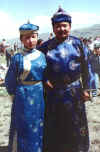 We happened
to be in Kyzyl for the celebration of the 80th anniversary of the founding of the city.
The festivities coincided with the annual "Naadam", or summer holiday, which
also happens to be the anniversary of Tuva's short-lived declaration of independence in
1921. Here's a photo of two Tuvans wearing
their best traditional robes, called a "del". It is similar to some old
Mongolian or Chinese clothing, but not quite the same. We happened
to be in Kyzyl for the celebration of the 80th anniversary of the founding of the city.
The festivities coincided with the annual "Naadam", or summer holiday, which
also happens to be the anniversary of Tuva's short-lived declaration of independence in
1921. Here's a photo of two Tuvans wearing
their best traditional robes, called a "del". It is similar to some old
Mongolian or Chinese clothing, but not quite the same.
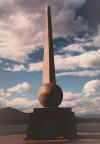 In the
1880's an eccentric Englishman named Proctor travelled the world, erecting monuments in
the centre of a few continents. By his calculations (not by today's maps) Kyzyl marked the
centre of Asia , and today an
obelisk stands where his wooden structure once stood, on the banks of the Yenisei. Even
this far south, at the headwaters of the Yenisei, it is an impressive river. As it flows
north to the Arctic it becomes one of the world's great rivers. In the
1880's an eccentric Englishman named Proctor travelled the world, erecting monuments in
the centre of a few continents. By his calculations (not by today's maps) Kyzyl marked the
centre of Asia , and today an
obelisk stands where his wooden structure once stood, on the banks of the Yenisei. Even
this far south, at the headwaters of the Yenisei, it is an impressive river. As it flows
north to the Arctic it becomes one of the world's great rivers.
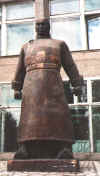 On Kyzyl's
main street is a statue called "Aldan
Maadyr" or "60 Heroes", dedicated to sixty nationalists who
rebelled against the Chinese rulers in 1885 and paid with their lives. The statue is
perhaps 10 feet tall. On Kyzyl's
main street is a statue called "Aldan
Maadyr" or "60 Heroes", dedicated to sixty nationalists who
rebelled against the Chinese rulers in 1885 and paid with their lives. The statue is
perhaps 10 feet tall.
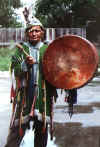
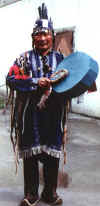 We spent
some time with some shamans; here are two pictures of shamans in their work clothes.
Shamanism was outlawed by the communists in 1938 (and shamans who could be located were
killed) but since the fall of the Soviet empire both shamanism and yellow-hat Buddhism
have been making a comeback. One older
shaman did a ceremony to keep us healthy, and the other shaman just watched. He reminded me of a
bear. We spent
some time with some shamans; here are two pictures of shamans in their work clothes.
Shamanism was outlawed by the communists in 1938 (and shamans who could be located were
killed) but since the fall of the Soviet empire both shamanism and yellow-hat Buddhism
have been making a comeback. One older
shaman did a ceremony to keep us healthy, and the other shaman just watched. He reminded me of a
bear.
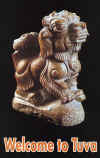 Right
before we left Tuva we happened to run into an assistant to the minister of tourism,
who gave us some brochures on tourism in his country. This is the cover of the pamphlet;
it's a photo of a small carving, called chonardash
, one of the traditional Tuvan crafts. The stone is fairly rare since it comes
from only one mountain, and is soft like soapstone when it's newly chipped out of the
ground but hardens within a few months. This is a good (but not great) example of the art,
and would probably sell for about $50 US. This sculpture is probably smaller than my fist. Right
before we left Tuva we happened to run into an assistant to the minister of tourism,
who gave us some brochures on tourism in his country. This is the cover of the pamphlet;
it's a photo of a small carving, called chonardash
, one of the traditional Tuvan crafts. The stone is fairly rare since it comes
from only one mountain, and is soft like soapstone when it's newly chipped out of the
ground but hardens within a few months. This is a good (but not great) example of the art,
and would probably sell for about $50 US. This sculpture is probably smaller than my fist.
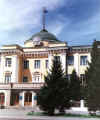 In Kyzyl
we were also fortunate to be granted an audience with the Chairman of the Supreme
Parliament, who is more akin to a prime minister or president than a speaker. His office
is in the parliament building .
Note the silver logo near the peak of the roof; this symbol, of the "flying
horseman", was a symbol of Tannu Tuva when it was independent (1921-1944) and has
been adopted as a symbol of the current Republic of Tuva. In Kyzyl
we were also fortunate to be granted an audience with the Chairman of the Supreme
Parliament, who is more akin to a prime minister or president than a speaker. His office
is in the parliament building .
Note the silver logo near the peak of the roof; this symbol, of the "flying
horseman", was a symbol of Tannu Tuva when it was independent (1921-1944) and has
been adopted as a symbol of the current Republic of Tuva.
Return to The Friends of Tuva Page.
| 

